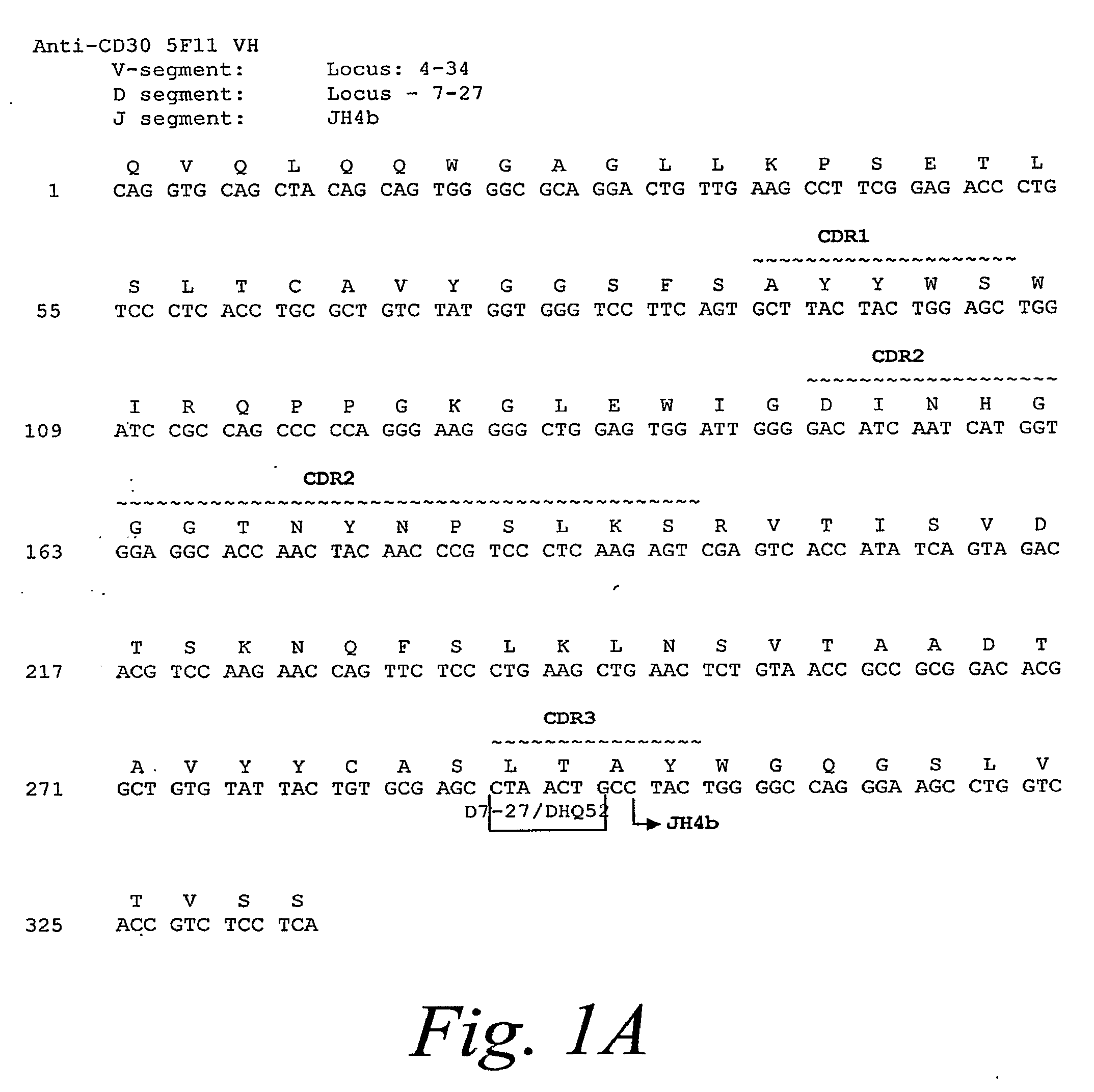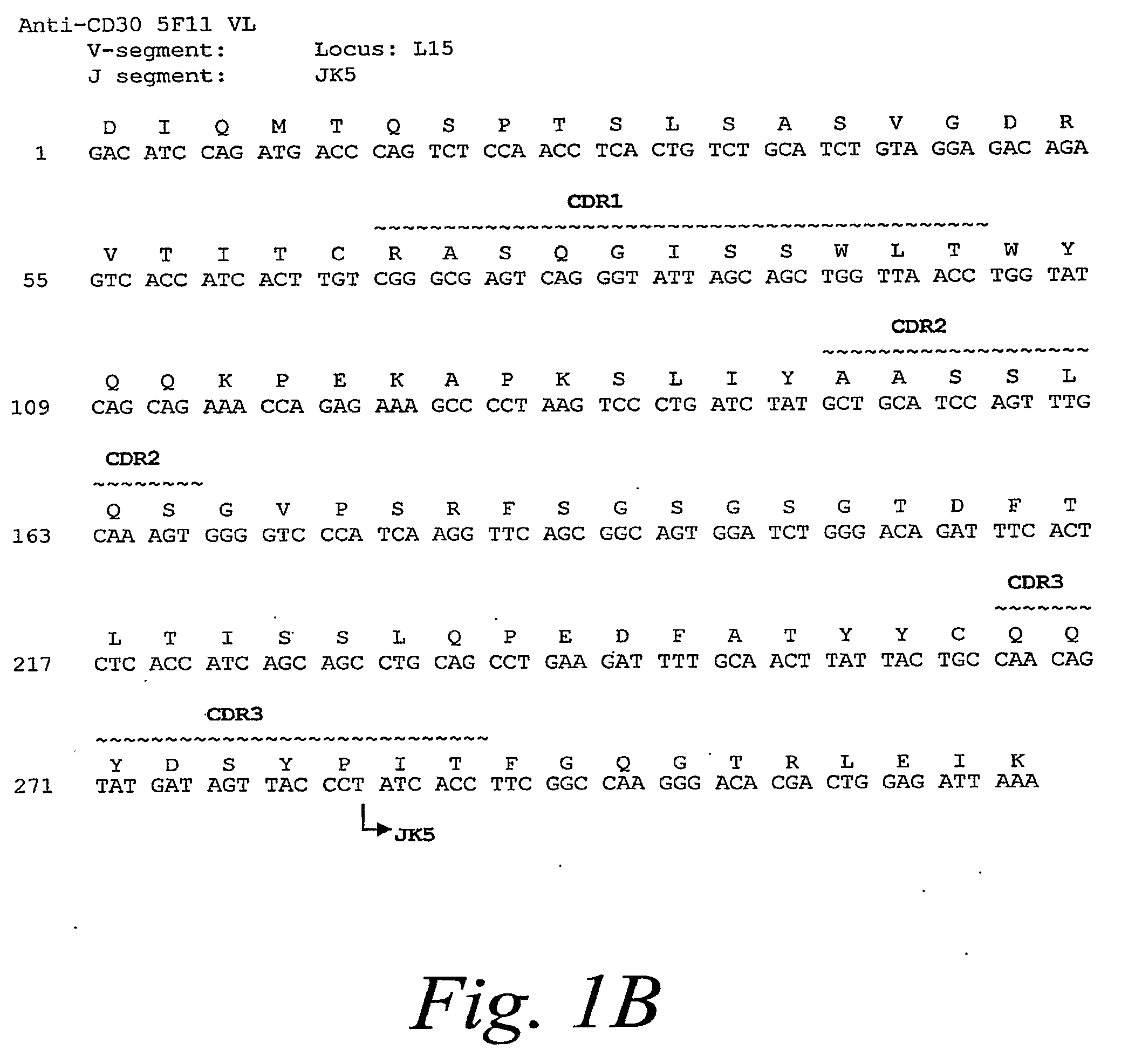Monoclonal antibodies against cd30 lacking in fucosyl and xylosyl residues
a technology of fucosyl and xylosyl, which is applied in the field of monoclonal antibodies against cd30 lacking in fucosyl and xylosyl residues, can solve the problems that the current availability of murine antibodies does not constitute ideal therapeutic agents, and passive antibody therapy has not been effective in vitro or in vivo against patients with refractory hodgkin's disease, and achieves the effect of enhancing antibody dependent cellular cytotoxicity (
- Summary
- Abstract
- Description
- Claims
- Application Information
AI Technical Summary
Benefits of technology
Problems solved by technology
Method used
Image
Examples
example 1
Preparation and Characterization of Defucosylated Anti-CD30 Monoclonal Antibody
[0355]In this example, a fully human anti-CD30 monoclonal antibody was expressed in a cell line lacking a fucosyl transferase enzyme such that the cell line produces proteins lacking fucosyl in their carbohydrates. The defucosylated antibody was tested against a fucosylated anti-CD30 antibody (expressed in a different cell line that contains the fucosyl transferase enzyme) to determine structural and characteristic differences between the antibodies, using a variety of chemical analysis techniques, including capillary electrophoresis, comparison of amino acid sequence, mass differences by mass spectroscopy and charge variation by capillary isoelectric focusing.
[0356]The anti-CD30 fully human monoclonal antibody 5F11 was originally described in PCT Publication WO 03 / 059282. The amino acid and nucleotide sequences of the 5F11 heavy chain is shown in FIG. 1A and the amino acid and nucleotide sequences of the...
example 2
Assessment of ADCC Activity of Defucosylated Anti-CD30 Antibody
[0363]The anti-CD30 monoclonal antibody 5F11 is capable of killing CD30+ cells through the recruitment of an effector cell population via antibody dependent cellular cytotoxicity (ADCC). In this example, defucosylated 5F11 (defuc-5F11) monoclonal antibodies were tested for the ability to kill CD30+ cell lines in the presence of effector cells in a cytotoxicity chromium release assay.
[0364]Human effector cells were prepared from whole blood as follows. Human peripheral blood mononuclear cells were purified from heparinized whole blood by standard Ficoll-paque separation. The cells were resuspended in RPMI1640 media containing 10% FBS and 200 U / ml of human IL-2 and incubated overnight at 37° C. The following day, the cells were collected and washed once in culture media and resuspended at 1×107 cells / ml. Two million target CD30+ cells were incubated with 200 μCi 51Cr in 1 ml total volume for 1 hour at 37° C. The target cel...
example 3
Assessment of ADCC Activity of Anti-CD30 Antibody
[0368]In this example, anti-CD30 monoclonal antibodies were tested for the ability to kill CD30+ cell lines in the presence of effector cells via antibody dependent cellular cytotoxicity (ADCC) in a fluorescence cytotoxicity assay. Human effector cells were prepared as described above and the ADCC assay performed as indicated above. As can be seen in FIG. 9, when using the defucosylated anti-CD30 antibody there was increased ADCC activity as compared with parental anti-CD30 antibody. In addition, the defucosylated anti-CD30 antibody was more potent than the parental antibody as evidenced by the reduced EC50 as compared to the parental anti-CD30 antibody. The antibody was also more efficacious as evidenced by the fact that the maximum percent lysis was higher for the defucosylated anti-CD30 antibody. With either antibody, the anti-CD16 (3G8) antibody effectively inhibited the ADCC suggesting that this lysis was mediated by CD16.
PUM
| Property | Measurement | Unit |
|---|---|---|
| dissociation constant | aaaaa | aaaaa |
| concentration | aaaaa | aaaaa |
| concentration | aaaaa | aaaaa |
Abstract
Description
Claims
Application Information
 Login to View More
Login to View More - R&D
- Intellectual Property
- Life Sciences
- Materials
- Tech Scout
- Unparalleled Data Quality
- Higher Quality Content
- 60% Fewer Hallucinations
Browse by: Latest US Patents, China's latest patents, Technical Efficacy Thesaurus, Application Domain, Technology Topic, Popular Technical Reports.
© 2025 PatSnap. All rights reserved.Legal|Privacy policy|Modern Slavery Act Transparency Statement|Sitemap|About US| Contact US: help@patsnap.com



